Preface
Dear Roadmap
“Why are you writing a book about product roadmaps? Does anyone even do those anymore?”
Each of us has been asked questions along these lines repeatedly over the last few months. We’ve also had the opposite reaction: “We’re redoing our roadmapping process right now. It’s so broken. When is your book coming out? Can I get a sneak preview?” At the same time that many are calling roadmaps old-fashioned, we’re seeing more and more people sign up for our roadmapping workshops.
Roadmaps were once required for any technology-related effort. They communicated specific deliverables and deadlines, and generally provided a comforting sense that everything was well planned and on track.
In the past decade, though, product roadmaps have become controversial. People seek the perfect roadmapping process and frequently end up disappointed. Many have actually abandoned the process in frustration, but retain this nagging sense that they are missing the strategic big picture.
As you read in the “Dear Roadmap” letters, product people are breaking up with their roadmapping process because it’s no longer delivering on its promise.
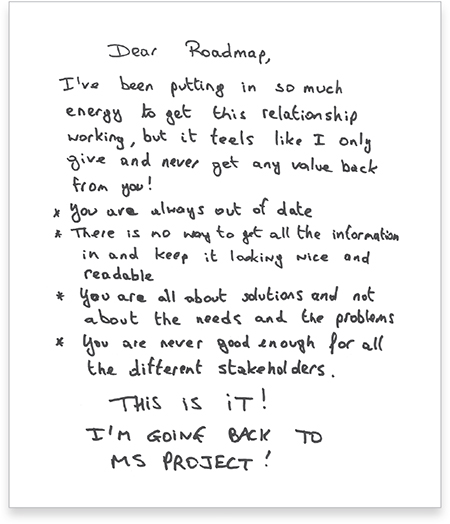
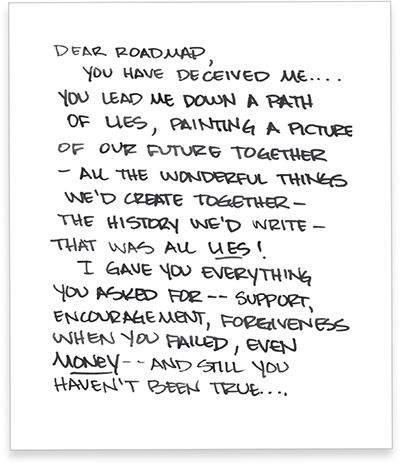
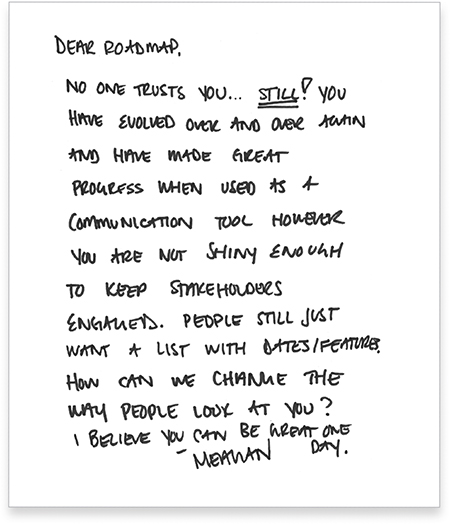
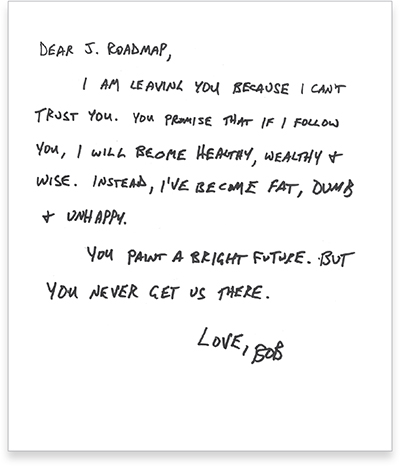
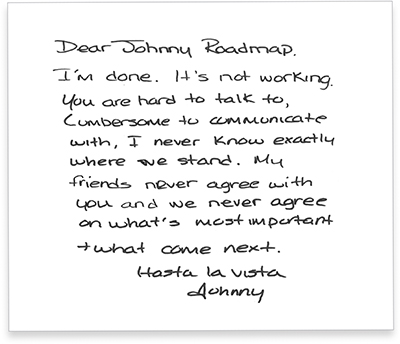
They want a document that:
Puts the organization’s plans in a strategic, value-oriented context
Is based on market and user research rather than guesswork and opinion
Gets customers excited about their product direction
Rallies their organization around a single set of priorities
Embraces learning and evolving as part of a successful product development process
Doesn’t require a wasteful process of up-front design and estimation
Perhaps the traditional product roadmap was once useful, when the goal (sell more units) was obvious, the pace of change was slower, and Moore’s law created a sense of inevitable and steady progress in the semiconductor industry of the 80s and 90s.
If this was ever true, though, it certainly has changed. It seems technology projects seldom, if ever, go according to plan. How many target ship dates have you actually hit? Exactly. Dates slip. Priorities change. Features are cut. Business models change. Companies “pivot.” Worse, as an industry, we’ve learned that those efforts that do go precisely to plan seldom deliver the value expected from the things the roadmap has outlined.
David Cancel, CEO of Drift and former head of product for HubSpot, summed up these frustrations well when he explained why he no longer puts together a traditional roadmap: “Either I’m going to disappoint you by giving you exactly what we thought six months ahead of time was the best solution when it’s not, or by changing course and having lied to you.”
Things have changed and product roadmaps haven’t caught up. They haven’t adapted to a world of lean and agile (some would even say post-agile) organizations. But there is still a need (even a hunger) for the vision, direction, and rallying cry that a good roadmap provides. To meet this need, roadmaps need a refresh—a relaunch, so to speak.
Fortunately, there is a new generation of product people developing a new breed of product roadmap. We’re seeing it come together in bits and pieces from sources as far apart as enterprise software, electronic components, consumer apps, business services, and even medicine.
We’ve assembled these best practices into a flexible framework that provides a powerful toolset for product people, and represents a new paradigm in product roadmapping.
Marty Cagan, founder of Silicon Valley Product Group and author of Inspired: How to Create Products Customers Love (SVPG Press), describes this new paradigm as follows: “It’s all about solving problems, not implementing features. Conventional product roadmaps are all about output. Strong teams know it’s not only about implementing a solution; they must ensure that solution actually solves the underlying problem. It’s about results.”
Intrigued?
Read on and join the relaunch of product roadmapping.
Who Is This Book For?
This book is written for product people. If you’re wondering if that’s you, we’re referring to the individual or individuals responsible for developing, prioritizing, and rallying support for the development of a product or service. This role has been compared to “a mini CEO,” but we think that overstates the level of control most product people have.
We prefer the analogy of the executive chef, the person who brings together kitchen staff, menu, and purchasing—and even trains the front-of-house staff—all in order to bring in customers, satisfy their hunger, and make money for the business. It is not enough for an executive chef to simply distribute the work, but each team member must understand whom they are serving, and why they are doing things a certain way, so as to create a seamless experience for the customer.
In many organizations (and particularly in technology organizations), this responsibility carries the title of product manager, product director, or product owner. Depending on the nature of your business and structure of your team, however, these duties may be handled by a myriad of other roles and functions, including project manager, development manager, engineering manager, technical lead, operations manager, program manager, user experience designer, customer success, quality assurance, and many more. In today’s fast-moving business environment, responsibilities and titles can change as frequently as the technologies we work with.
We wrote this book to be accessible to anyone involved in product, regardless of title. If your job includes strategizing about where your product is going, contributing to alignment around a shared vision, or developing a plan to execute, then we hope this book will be relevant, enlightening, and useful to you.
In addition, we want this book to be useful for product people of all experience levels. Whether you’re a product “newbie,” a seasoned veteran, or a senior leader responsible for a range of products (or a team of product people), we believe the approach we describe here will help you and your team communicate product direction effectively.
Maybe you had never heard of product roadmapping before you came across this book. That’s OK! (Welcome aboard, we have life jackets.) If you’re new to product development or new to the concept of roadmapping, we’ve designed this book to be a helpful introduction.
Or maybe you have a product roadmapping process but have realized it’s flawed. Maybe what you thought was a product roadmap was actually a business plan, a marketing plan, or a project plan.
Recognizing that you don’t have a working product roadmapping process is actually a great place to be. This means you can wipe the slate clean and start fresh.
How to Use This Book
Product roadmapping isn’t a destination; rather, it’s a journey, marked by a collection of actions that help define how to deliver the highest possible value to the customer. The following list identifies the key principles we’ve found are crucial to a successful product roadmap. You may already have some of these in place, and each company, product, and set of stakeholders is different, so we’ll talk about how you can mix and match based on your needs and the readiness of your organization.
Gather inputs (Chapter 3)
Establish the product vision (Chapter 4)
Uncover customer needs (Chapter 5)
Dive deeper into needs and solutions (Chapter 6)
Master the art and science of prioritization (Chapter 7)
Achieve buy-in and alignment (Chapter 8)
Present and share (Chapter 9)
Keep it fresh (Chapter 10)
We’ve organized the core of this book in the order of these tasks; however, our research has found that there’s no “right” order. In addition, Chapter 1 makes the case for a new approach to product roadmapping, Chapter 2 provides an overview of the core components, and Chapter 11 summarizes the entire process.
Roadmapping is not something most product people do every day. Like good cuisine, it is seasonal. So, like your favorite cookbook, this book was designed as a reference you can keep handy to refresh your memory on the intricacies, options, and pitfalls associated with each step along the way.
Why Listen to Us?
As long-time product people ourselves, we’ve spent decades exploring and using different approaches to product roadmapping. Every organization we’ve worked for or with has had slightly different needs, and our approaches have varied with them. Upon reflecting on these experiences and comparing approaches, we developed this common framework that we believe any product person can benefit from.
C. Todd Lombardo
Having made all the mistakes one makes as a product manager, C. Todd Lombardo spent over seven years in product at a variety of organizations from startup to enterprise. Trained in science, design, and business, he not only has too many degrees, he loves combining the approach of all three disciplines in his endeavors. He’s the Head of Product & Experience at Boston-based Workbar, an Adjunct Professor at IE Business School in Madrid, and coauthor of the first book on Design Sprints, appropriately titled Design Sprint (O’Reilly).
Bruce McCarthy
As a young man, Bruce used LEGOs to obtain food and attract a mate. Product is probably encoded somewhere in his DNA. His is currently president of the Boston Product Management Association (BPMA) and CEO of UpUp Labs.
For some years now, Bruce has been speaking to standing room–only crowds about product roadmapping and strategic prioritization at ProductCamps and other conferences around the world.
He and his team help organizations get more from their investments in product development, working with companies such as Vistaprint, Localytics, Zipcar, Johnson & Johnson, and Huawei, providing coaching, mentoring, and tools such as Awesomeness, a solution for measurably enhancing team effectiveness.
Evan Ryan
To build is to learn. For Evan, creating products and services is about solving mission-critical problems to make the world a better place, but just as important, a chance to learn and explore. Product work provides him with an outlet for his insatiable curiosity.
Evan is an experienced product leader and entrepreneur who has brought dozens of products from concept to market for both consumer and enterprise audiences. He specializes in understanding ecosystems and extracting user insights to guide strategy and drive innovation. As a founder, his companies have served a diverse variety of organizations, from startups, to nonprofits, to Fortune 500 companies, including Apple, Deloitte, Chevron, Sonos, Stanford University, and others.
Evan extends his knowledge and learning to others through speaking engagements, custom workshops, and as an adjunct professor who teaches classes on design and entrepreneurship. This is his first book for O’Reilly Media, but the writing bug is now firmly embedded.
Michael Connors
Michael has spent his career as a designer of all kinds of digital and print deliverables. He was trained as a fine artist and has an MFA in Painting. Currently, he’s the Creative Director at Fresh Tilled Soil, a Boston-based UX/UI design firm, where he works on digital products for major brands, startups, and everything in between. He’s also an Adjunct Professor at IE Business School in Madrid and has been an adjunct design instructor at other institutions of higher ed for many years. He lives in Northampton, Massachusetts where he enjoys his front porch every chance he gets.
Acknowledgments
C. Todd would like to thank all the product teams we interviewed on the journey to this book; Faye Boeckman and John Linnan—you were two of my first product mentors, and your wisdom has guided me for years after we worked together; Bruce and Evan for agreeing to come on this book-writing journey with me; MC for bringing the design awesomesauce and framing the content in such a professorial manner; the amazing team at Mind the Product for connecting us with just about any product person on the planet; the team at Fresh Tilled Soil for being patient with Evan and I while we pursued this crazy roadmapping thing; and my colleagues at Workbar who inspire me to make the best damn products I’ve ever made. It goes without saying that the team at O’Reilly was supportive and helpful in helping us bring this concept to life, and I’m so grateful for the opportunity to publish this book with you.
Bruce would like to thank Anthony Accardi for reminding us to focus on the “why” of what’s on the roadmap; Ben Foster for making it clear why alignment is at least as important as strategy; Bill Allen for describing the ideal practice of shuttle diplomacy; Bob Levy for describing how customers can influence the roadmap constructively; Jeff Bussgang for calling bullshit on roadmap unbelievers; Emily Tyson for describing the use of confidence in a roadmap; Matt Peopsel for articulating the proper use of themes; Steve Blank for articulating the weaknesses in the traditional roadmap; Bryan Dunn for the nine-hour roadmap and using the roadmap to say no; David Cancel for being his contrarian self; Frank Capria for insights on how much to share with customers and sales; Alex Kohlhofer for cautioning against recency bias; Andrea Blades for letting him experiment on her team; Gillian Daniel for validating so much of our framework; Janna Bastow for highlighting the differences between public and internal roadmaps; Jim Kogler for describing the organic process of customer feedback; Jim Semick for reminding us of the value of fuzziness in planning; Jim Garretson for highlighting the differences between buyer and user priorities; John Mansour for crisply describing the difference between a roadmap and a release plan; Joseph Gracia for describing the value of conversation with stakeholders; Julia Austin for reminding us to balance strategic direction with customer feedback; Matt Morasky for thoughts on small increments; Michael Salerno for bringing us back to the problem statement; Nate Archer for recognizing roadmapping as an emergent behavior of effective teams; Nils Davis for describing the relationship between the roadmap and the detail hidden beneath; Roger Cauvin for explaining how he uses roadmaps to focus the team on a product vision; Rose Grabowski for beautifully describing the roadmap as a sales document; Saeed Kahn for revealing how creating a roadmap improves his product strategy; Samuel Clemens for describing the roadmap itself as his product; Sarela Bliman-Cohen for tying themes to market segments; Sherif Mansour for the concepts of persona-driven, goal-driven, and vision-driven roadmaps; Teresa Torres for her amazing Opportunity Solution tree visualization; Torrance Robinson for articulating how to use roadmaps to keep yourself honest; and Vanessa Ferranto for highlighting the difference between a problem and a hypothesis.
Thanks are due also to Bruce’s colleagues and friends at the Boston Product Management Association (BPMA) for their unfailing support. And to all of the reviewers who gave positive and constructive feedback throughout the book. Bruce would especially like to thank Keith Hopper for his relentless and detailed candor. The book is much better for all of your attention.
Bruce would also like to thank C. Todd for persuading (OK, arm-twisting) him to be part of this effort; Andrew Shepard and Steve Robins for egging him on; his daughter, Amanda McCarthy, for being the world’s fastest (and most accurate) copy editor and quote wrangler; Sandra Ocasio for patiently scheduling and rescheduling about a million Skype interviews; Angela Rufino for the patience of Job (and like Job, for never giving up); and the love of his life, Christine Moran McCarthy, for understanding he needed to do this.
Evan would like to thank his coauthors for enduring his endless search for answers with grace and humor and for the constant willingness to weather new depths of exploration (even after exhaustion set in). For the great team of editors and advisors at O’Reilly, thank you for the encouragement to write the book and the flexibility needed to work through countless revisions. To his fellow product leaders, those he knows well and those he doesn’t know yet, thank you for the constant inspiration. His contributions to this book are supported by the expertise and encouragement of his peers in the product space. Your willingness to be interviewed and answer hard questions provided the canvas on which we could work. To the friends, family members, investors, advisors, and mentors that supported him at every step in his entrepreneurial wanderings, a deep, deep thank you. Without your guidance and generosity, he would not be where he is today, and writing a book like this would be a distant goal. Thank you as well to his FTS colleagues for being willing guinea pigs on all things roadmap, and to the leadership for clearing a path and supporting this project. To his close friends, a deep thank you for keeping him sane. To his immediate family—mom, dad, Casey, and Kellie—thank you for your endless confidence and support. Finally, to his wife, Jenna, thank you for your love and unquestioning faith. You inspire me to keep striving.
Michael would like to thank his coauthors for many things, but first for inviting him to be a part of this book. Also in tirelessly defining and refining the book’s core concepts and structure, their willingness to share and debate ideas openly and freely, and their commitment to create something useful; the entire O’Reilly team, but especially Melanie and Angela (rockstars); his friends, colleagues, collaborators, students, advisors, clients (many of whom are also the former) on the project teams that have helped him hone his craft; his parents, Bob and Ellie; his siblings for keeping him honest and for challenging everything (and he means everything) all these years; the countless, largely anonymous “blue-collar” designers, creatives, and craftspeople that have created, and still create the rich visual and experiential culture from which we all benefit.
Product roadmaps can take many forms, and aren’t necessarily a single artifact or document. In fact, it’s really not about creating artifacts at all—it’s about creating a shared understanding of where you’re going and why.
Get Product Roadmaps Relaunched now with the O’Reilly learning platform.
O’Reilly members experience books, live events, courses curated by job role, and more from O’Reilly and nearly 200 top publishers.

